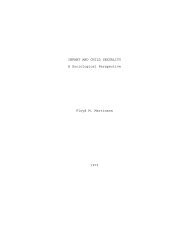1 Social Response to Age-Gap Sex Involving Minors ... - Ipce
1 Social Response to Age-Gap Sex Involving Minors ... - Ipce
1 Social Response to Age-Gap Sex Involving Minors ... - Ipce
You also want an ePaper? Increase the reach of your titles
YUMPU automatically turns print PDFs into web optimized ePapers that Google loves.
10<br />
down. Both younger and older participants generally seem excited. These behaviors are never<br />
aggressive and appear <strong>to</strong> reduce tension between the them. 24 Similar age-gap relations occur<br />
daily and universally in Mona monkeys; the sexual interactions are almost never aggressive and<br />
appear <strong>to</strong> help the younger males integrate in<strong>to</strong> the male group and <strong>to</strong> maintain group cohesion. 25<br />
When it comes <strong>to</strong> human age-gap sexual relations, the stereotype is that they are, by<br />
nature, aggressive encounters, where the older person imposes his will on an unwilling younger<br />
partner, who is traumatized and psychologically ruined. It is striking, then, that we find just the<br />
opposite in the primate data, where researchers document that eagerness and even initiative on<br />
the part of the younger animal are commonplace, 26 and they repeatedly describe positive<br />
developmental and social functions that these relations appear <strong>to</strong> serve—just as his<strong>to</strong>rians and<br />
anthropologists also have also done with regard <strong>to</strong> other times and cultures.<br />
Concluding Remarks<br />
<strong>Age</strong>-gap sex with minors greatly misfits modern social and economic structures, and<br />
therefore the multi-perspective review just presented does not suggest that we endorse this<br />
behavior. But the review does show a significant disconnect between sweeping assumptions of<br />
intrinsic pathology and pervasive devastation on the one hand and the much less alarmist, and<br />
24 Ogawa, H. (1995). Wily monkeys: <strong>Social</strong> intelligence of Tibetan macaques. University of Kyo<strong>to</strong> Press/Trans<br />
Pacific Press.<br />
25 Glenn, M. E., Ramsier, M., and Benson, K. J. (2006). Homosexual behavior and long-term bonding in wild Mona<br />
monkey all-male groups. Paper presented at the International Association of <strong>Sex</strong> Research conference, Amsterdam,<br />
Netherlands, July, 15.<br />
26 Many biologists and others have argued that animal homosexuality is about asserting dominance, not sex.<br />
Biologist Bruce Bagemihl (see footnote 19), in his seminal work Biological Exuberance, has decisively refuted this<br />
view. Many species without dominance hierarchies have homosexual behavior. Many other species with dominance<br />
hierarchies do not have homosexual behavior. In species with both dominance hierarchies and homosexual behavior,<br />
it is often the subordinate animal that plays the active role. For our purposes here, male homosexual relations in<br />
primates and other mammals often involve juveniles with older males. But these relations, as just noted, are usually<br />
not based on assertions of dominance. In humans, a parallel claim has often been that such relations are based on<br />
assertions of power. The animal data contradict this. So do the non-clinical human data discussed previously. These<br />
empirical results indicate that the sweeping assertion that wielding power is the basis for human age-gap sexual<br />
relations is incorrect. Critical evaluation of this assertion instead shows it <strong>to</strong> be an ideological construction (see<br />
Angelides, 2004, 2005, in footnote 11).
















